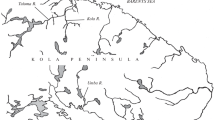Abstract
The effect of subdivision on the effective size (N e) of the early-run sockeye salmon Oncorhynchus nerka population of Lake Azabach’e (Kamchatka Peninsula) has been studied. The mode of this effect is determined by the relative productivity of the subpopulations and its magnitude, by the rate of individual migration among subpopulations and genetic differentiation. If the contributions of subpopulations (offspring numbers) are different, genetic differentiation can reduce the N e of the subdivided population. At equal subpopulation contributions, genetic differentiation always increases the N e of the subdivided population in comparison with a panmictic population. We have found that all sockeye salmon subpopulations of Azabach’e Lake produce equal offspring numbers contributing to the next generation. The genetic differentiation between sockeye salmon subpopulations is low, and the subdivision increases the N e of the early-run race with reference to the sum of the effective sizes of the subpopulations by as little as 2%.
Similar content being viewed by others
REFERENCES
Efremov, V.V. and Parenskii, V.A., Effective Size of Subpopulations in Early-Run Sockeye Salmon Oncorhynchus nerka from Azabech’e Lake (Kamchatka): The Effect of Density on Variance of Reproductive Success, Rus. J. Genet., 2004, vol. 40, no.4, pp. 431–436.
Efremov, V.V., Effective Size of Subpopulations in Early-Run Sockeye Salmon Oncorhynchus nerka from Azabech’e Lake (Kamchatka): The Effect of Relative Reproductive Success of Different-Year Cohorts, Rus. J. Genet., 2004, vol. 40, no.5, pp. 524–529.
Konovalov, S.M., Populyatsionnaya biologiya tikhookeanskikh lososei (Population Biology of Pacific Salmon), Leningrad: Nauka, 1980.
Glubokovsky, M.K., Evolyutsionnaya biologiya lososevykh ryb (Evolutionary Biology of Salmonids), Moscow: Nauka, 1995.
Altukhov, Yu.P., Salmenkova, E.A., and Omel’chenko, V.T., Populyatsionnaya genetika lososevykh ryb (Population Genetics of Salmonids), Moscow: Nauka, 1997.
Il’in, V.E., Konovalov, S.M., and Shevlyakov, A.G., Coefficient of Migration and the Spatial Structure of Pacific Salmon, in Biologicheskie osnovy razvitiya lososevogo khozyaistva v vodoemakh SSSR (Biological Basis for the Development of Salmon Farming in Water Bodies of the USSR), Moscow: Nauka, 1983, pp. 9–18.
Semenchenko, N.N. and Ostrovskii, V.I., Migration of Sockeye Salmon Oncorhynchus nerka Spawners from Individual Subisolates of Azabach’e Lake (Kamchatka) in Years of High Population Sizes, Vopr. Ikhtiol., 2001, no. 1, pp. 42–46.
Wright, S., Isolation by Distance, Genetics, 1943, vol. 28, pp. 114–138.
Kimura, M., Stepping-Stone Model of Population, Ann. Rep. Nat. Inst. Genet., 1953, vol. 3, pp. 63–65.
Nei, N. and Takahata, N., Effective Population Size, Genetic Diversity and Coalescence Time in Subdivided Populations, J. Mol. Evol., 1993, vol. 37, pp. 240–244.
Wang, J. and Caballero, A., Developments in Predicting the Effective Size of Subdivided Populations, Heredity, 1999, vol. 82, pp. 212–226.
Maruyama, T., On the Rate of Decrease of Heterozygosity in Circular Stepping-Stone Models of Populations, Theor. Pop. Biol., 1970, vol. 1, pp. 101–119.
Whitlock, M. and Barton, N., The Effective Size of a Subdivided Population, Genetics, 1997, vol. 146, pp. 427–441.
http://www.statsoft.com
Varnavskaya, N.V., Wood, C.C., Everett, R.J., et al., Genetic Differentiation of Subpopulations of Sockeye Salmon (Oncorhynchus nerka) within Lakes of Alaska, British Columbia, and Kamchatka, Russia, Can. J. Fish. Aquat. Sci., 1994, vol. 51,suppl., pp. 147–157.
Allendorf, F.W. and Seeb, L.W., Concordance of Genetic Divergence among Sockeye Salmon Populations at Allozyme, Nuclear DNA, and Mitochondrial DNA Markers, Evolution, 2000, vol. 54, pp. 640–651.
Seeb, L.W., Habicht, C., Templin, W.D., et al., Genetic Diversity of Sockeye Salmon of Cook Inlet, Alaska, and Its Application to Management of Populations Affected by the Exxon Valdez Oil Spill, Trans. Am. Fish. Soc., 2000, vol. 129, pp. 1223–1249.
Vernon, E.H., Morphometric Comparison of Three Races of Kokanee (Oncorhynchus nerka) within a Large British Columbia Lake, J. Fish. Res., 1957, vol. 14, pp. 573–598.
Hartman, W.L. and Raleigh, R.F., Tributary Homing of Sockeye Salmon at Brooks and Karluk Lakes, Alaska, J. Fish. Res., 1964, vol. 21, pp. 485–504.
Varnavskii, V.S. and Varnavskaya, N.V., Estimation of Migration among Intrapopulation Groups of an Early-Spawning Race of Sockeye Salmon Oncorhynchus nerka (Walbaum) (Salmonidae) of Nachikinskoe Lake (Kamchatka), Vopr. Ikhtiol., 1985, no. 1, pp. 157–159.
Birky, C.W., Maruyama, T., and Fuerst, P., An Approach to Population and Evolutionary Genetic Theory for Genes in Mitochondria and Chloroplasts, and Some Results, Genetics, 1983, vol. 103, pp. 513–527.
Wright, S., The Genetic Structure of Populations, Ann. Eugen., 1951, vol. 15, pp. 323–354.
Wright, S., The Interpretation of Population Structure by F-Statistics with Special Regard to System of Mating, Evolution, 1965, vol. 19, pp. 395–420.
Robertson, A., The Effect of Non-Random Mating within Inbred Lines on the Rate of Inbreeding, Genet. Res., 1964, vol. 5, pp. 164–167.
Kimura, M. and Ohta, T., Theoretical Aspects of Population Genetics, Princeton: Princeton Univ. Press, 1971.
Ostroumov, A.G., Spawning Stock of Salmon and Dynamics of Its Size in the Basin of Azabach’e Lake According to Aerosurveying and Aerophotography, Izv. Tikhook. Inst. Rybn. Khoz. Okeanogr., 1972, vol. 82, pp. 135–142.
Foerster, R.E., The Sockeye Salmon, Oncorhynchus nerka, Bull. Fish. Res, 1968, vol. 162.
Quinn, T.P., Wood, C.C., Margolis, L., et al., Homing in Wild Sockeye Salmon (Oncorhynchus nerka) Populations As Inferred from Differences in Parasite Prevalence and Allozyme Allele Frequencies, Can. J. Fish. Aquat. Sci., 1987, vol. 44, pp. 1963–1971.
Author information
Authors and Affiliations
Additional information
__________
Translated from Genetika, Vol. 41, No. 5, 2005, pp. 680–685.
Original Russian Text Copyright © 2005 by Efremov.
Rights and permissions
About this article
Cite this article
Efremov, V.V. Effective Size of the Early-Run Sockeye Salmon Oncorhynchus nerka Population of Lake Azabach’e, Kamchatka Peninsula Evaluation of the Effect of Interaction between Subpopulations within a Subdivided Population. Russ J Genet 41, 548–552 (2005). https://doi.org/10.1007/s11177-005-0125-6
Received:
Issue Date:
DOI: https://doi.org/10.1007/s11177-005-0125-6




